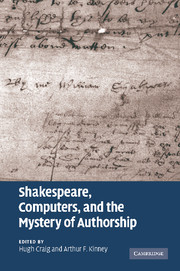Book contents
- Frontmatter
- Contents
- List of figures
- List of tables
- Notes on contributors
- Preface and acknowledgments
- 1 Introduction
- 2 Methods
- 3 The three parts of Henry VI
- 4 Authoring Arden of Faversham
- 5 Edmond Ironside and the question of Shakespearean authorship
- 6 The authorship of The Raigne of Edward the Third
- 7 The authorship of the Hand-D Addition to The Book of Sir Thomas More
- 8 The 1602 Additions to The Spanish Tragedy
- 9 Transforming King Lear
- Conclusion
- Appendix A Plays in the corpus
- Appendix B A list of 200 function words
- Glossary
- Index
Conclusion
Published online by Cambridge University Press: 06 January 2010
- Frontmatter
- Contents
- List of figures
- List of tables
- Notes on contributors
- Preface and acknowledgments
- 1 Introduction
- 2 Methods
- 3 The three parts of Henry VI
- 4 Authoring Arden of Faversham
- 5 Edmond Ironside and the question of Shakespearean authorship
- 6 The authorship of The Raigne of Edward the Third
- 7 The authorship of the Hand-D Addition to The Book of Sir Thomas More
- 8 The 1602 Additions to The Spanish Tragedy
- 9 Transforming King Lear
- Conclusion
- Appendix A Plays in the corpus
- Appendix B A list of 200 function words
- Glossary
- Index
Summary
‘For the last three centuries, Shakespearean scholars have emphatically argued that the transmission of an English early modern play-text was linear: that is, from an author to acting company to theatre audience to printer to literary audience’, Grace Ioppolo writes. But this is not so. ‘Signifi cant evidence’, she continues, ‘from dramatic manuscripts, including the handwriting of company scribes, book-keepers and censors alongside that of authors, suggests instead that this transmission is … circular and that neither authors nor theatre personnel dissociated authors from their texts. In fact authors returned to their texts, or texts were returned to their authors, at any or all stages after composition.’ Drawing on the Henslowe and Alleyn archive in detail – and on contracts, fi nancial accounts, correspondence, depositions, and commentaries – she fi nds abundant evidence that the author might revisit his play script ‘after the scribe had copied it; after a censor had licensed it; after the book-keeper had prepared the company book; after its rehearsal and performance; before one or more later revivals; and after it was printed’ (p. 99). Philip Henslowe, for instance, records that he paid 20 shillings for authorial revision on 15 May 1602: ‘harey chattel for the mendynge of the fyrste parte of carnowlle wollsey’, a work he had initially commissioned from Chettle one year earlier.
- Type
- Chapter
- Information
- Shakespeare, Computers, and the Mystery of Authorship , pp. 202 - 211Publisher: Cambridge University PressPrint publication year: 2009

